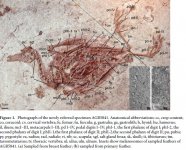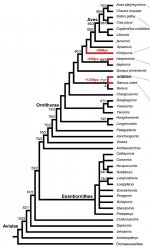Fred Ruhe
Well-known member

Xia Wang, Jiandong Huang, Yuanchao Hu, Xiaoyu Liu, Jennifer Peteya & Julia A. Clarke, 2018
The earliest evidence for a supraorbital salt gland in dinosaurs in new Early Cretaceous ornithurines
Scientific Reportsvolume 8: 3969
Abstract: http://www.nature.com/articles/s41598-018-22412-8
Supraorbital fossae occur when salt glands are well developed, a condition most pronounced in marine and desert-dwelling taxa in which salt regulation is key. Here, we report the first specimens from lacustrine environments of the Jehol Biota that preserve a distinct fossa above the orbit, where the salt gland fossa is positioned in living birds. The Early Cretaceous ornithurine bird specimens reported here are about 40 million years older than previously reported Late Cretaceous marine birds and represent the earliest described occurrence of the fossa. We find no evidence of avian salt gland fossae in phylogenetically earlier stem birds or non-avialan dinosaurs, even in those argued to be predominantly marine or desert dwelling. The apparent absence of this feature in more basal dinosaurs may indicate that it is only after miniaturization close to the origin of flight that excretory mechanisms were favored over exclusively renal mechanisms of salt regulation resulting in an increase in gland size leaving a bony trace. The ecology of ornithurine birds is more diverse than in other stem birds and may have included seasonal shifts in foraging range, or, the environments of some of the Jehol lakes may have included more pronounced periods of high salinity.
Free pdf: http://www.nature.com/articles/s41598-018-22412-8.pdf
Enjoy,
Fred
The earliest evidence for a supraorbital salt gland in dinosaurs in new Early Cretaceous ornithurines
Scientific Reportsvolume 8: 3969
Abstract: http://www.nature.com/articles/s41598-018-22412-8
Supraorbital fossae occur when salt glands are well developed, a condition most pronounced in marine and desert-dwelling taxa in which salt regulation is key. Here, we report the first specimens from lacustrine environments of the Jehol Biota that preserve a distinct fossa above the orbit, where the salt gland fossa is positioned in living birds. The Early Cretaceous ornithurine bird specimens reported here are about 40 million years older than previously reported Late Cretaceous marine birds and represent the earliest described occurrence of the fossa. We find no evidence of avian salt gland fossae in phylogenetically earlier stem birds or non-avialan dinosaurs, even in those argued to be predominantly marine or desert dwelling. The apparent absence of this feature in more basal dinosaurs may indicate that it is only after miniaturization close to the origin of flight that excretory mechanisms were favored over exclusively renal mechanisms of salt regulation resulting in an increase in gland size leaving a bony trace. The ecology of ornithurine birds is more diverse than in other stem birds and may have included seasonal shifts in foraging range, or, the environments of some of the Jehol lakes may have included more pronounced periods of high salinity.
Free pdf: http://www.nature.com/articles/s41598-018-22412-8.pdf
Enjoy,
Fred





